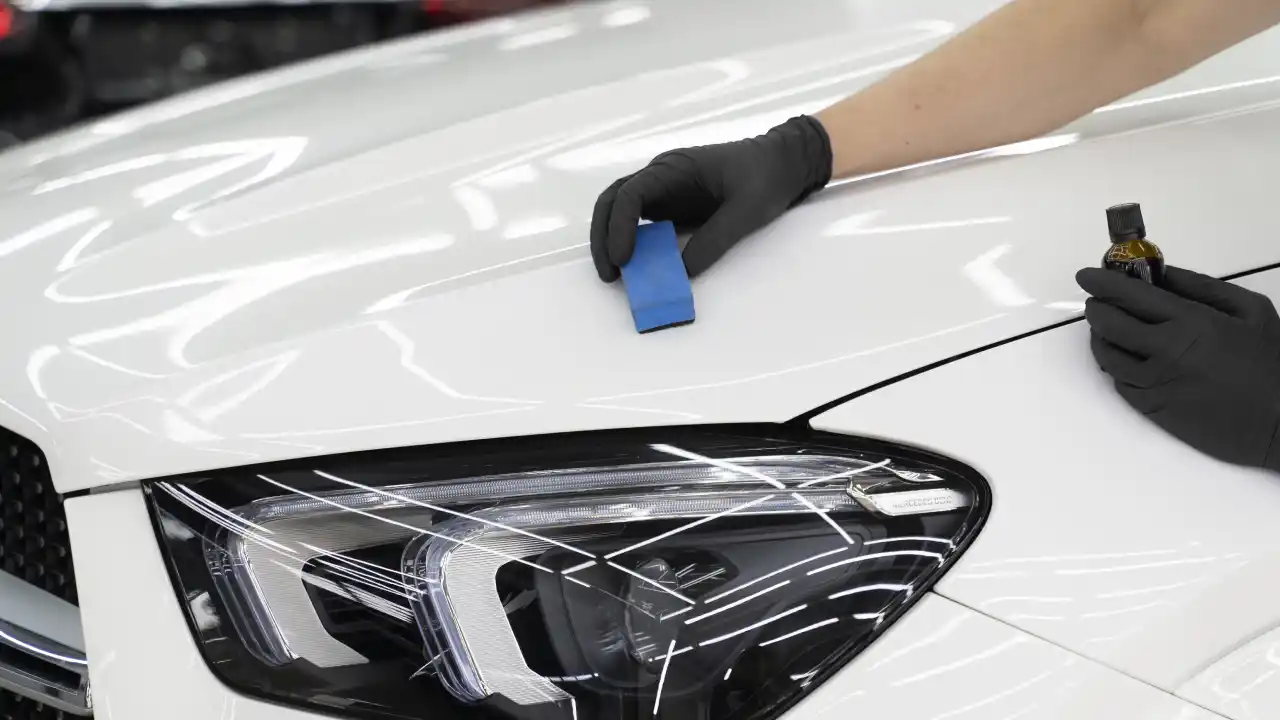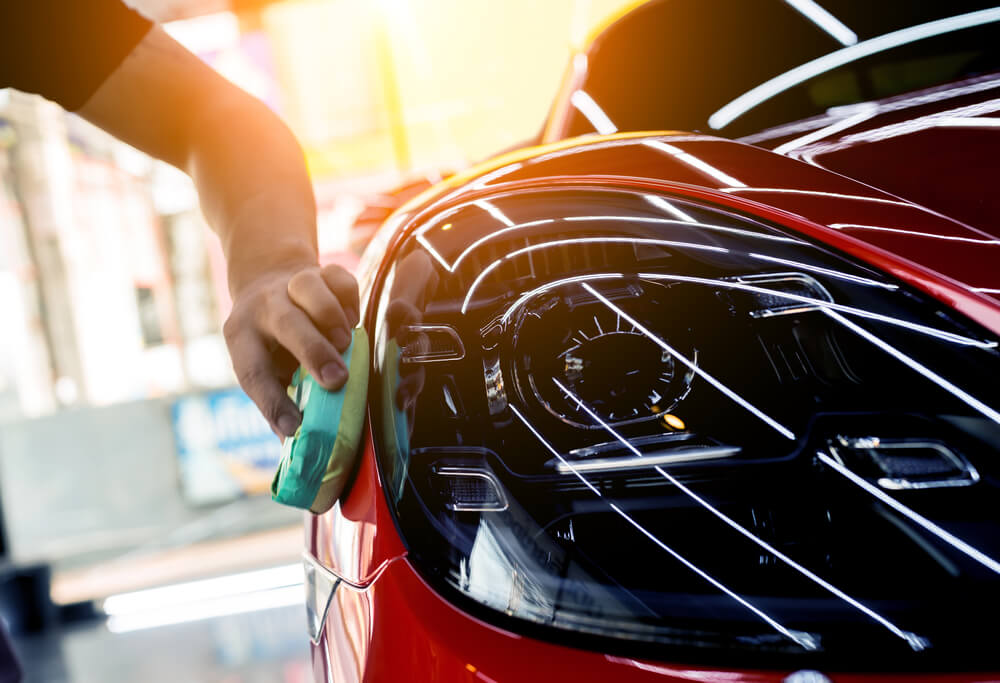The Relevance of Ceramic Coating: Shielding Your Auto's Outside With Precision
In an era where keeping the functional and visual integrity of your vehicle is extremely important, ceramic finish becomes a pivotal remedy. This protective layer not just defend against environmental hardships yet likewise elevates the aesthetic appeal of your auto. With its special bonding residential or commercial properties, ceramic coating supplies a level of defense that much surpasses traditional waxing approaches. Just how specifically does it attain such impressive outcomes? As we explore the subtleties of its application and contrast it to other alternatives, one can not question but assist about the specifics that make this modern technology important for modern auto care.
Benefits of Ceramic Coating
When it comes to protecting an automobile's aesthetic appeal, ceramic coating supplies substantial benefits. By developing a semi-permanent bond with the automobile's paint, ceramic finishings successfully stop oxidation and fading, making sure that the automobile maintains a shiny, showroom-like coating for a prolonged period.
In enhancement to its safety qualities, ceramic covering supplies exceptional hydrophobic properties, creating water and other liquids to grain off effortlessly. This attribute simplifies the cleansing process, as dirt and debris are less most likely to adhere to the surface area, minimizing the frequency and initiative required for upkeep. Moreover, the finishing's resistance to chemical stains from acidic contaminants like bird droppings and tree sap is one more noteworthy advantage, decreasing possible paint damages.
Ceramic layers also boost scrape resistance, offering a layer that can soak up minor abrasions and swirl marks. This quality is specifically useful in keeping a pristine surface, lowering the likelihood of visible blemishes and preserving the stability of the auto's paintwork over time.

How Ceramic Finish Functions
Understanding the mechanics behind ceramic finishing exposes its efficiency as a safety remedy for vehicles. Ceramic finishings are basically liquid polymer applications that chemically bond with an auto's manufacturing facility paint, creating a safety layer. This layer functions as a barrier against environmental pollutants such as grime, ultraviolet, and dirt rays, which can weaken a car's exterior gradually. The vital part in ceramic coating is silicon dioxide (SiO2), which originates from quartz crystals and is known for its remarkable solidity and resilience.
Application of ceramic finish includes a careful process. The vehicle's surface area need to be thoroughly cleaned and decontaminated to make certain ideal adhesion. As soon as applied, the fluid polymer develops a semi-permanent bond with the paint, hardening right into a transparent, durable guard. This shield boosts the cars and truck's gloss and hydrophobic homes, promoting much easier cleaning by creating water and contaminants to grain and slide off effortlessly.
In addition, the finishing's molecular framework provides resistance to small scratches and chemical spots. Unlike waxes or sealers that sit on top of the paint, ceramic finishes incorporate with the surface, using long-lasting security. This integration is basic to its efficiency, ensuring the automobile's coating remains beautiful for several years.
Comparing Ceramic Coating to Alternatives
In the world of auto protection, ceramic finishing stands as a powerful choice when contrasted to typical choices such as waxes and sealants. While waxes use a short-lived glossy finish, normally lasting just a couple of weeks to months, ceramic coverings offer a longer-lasting option, commonly sustaining for years. This longevity is credited to the chemical bonding that occurs when ceramic finishings are used, creating a strong layer that is immune to ecological dangers.
Contrastingly, sealers, although even more resistant than waxes, still drop brief of the durable protection provided by ceramic finishes. Sealants can typically last for as much as a year, supplying an artificial shield versus particular elements. They lack the superior hydrophobic buildings and UV security that ceramic coatings supply.
Furthermore, ceramic finishings provide boosted scratch resistance, which neither waxes nor sealers can successfully match (ceramic coating). This is particularly beneficial in preserving an automobile's immaculate published here appearance. In addition, ceramic finishings streamline maintenance initiatives by decreasing the adherence of dust and grime, consequently helping with less complicated cleaning. In recap, while conventional waxes and sealants use basic security, ceramic coatings provide a comprehensive, long-lasting remedy that considerably preserves the automobile and boosts's outside coating.
Application Refine Clarified
Applying ceramic finish to a lorry calls for a meticulous process to make certain optimal outcomes and sturdiness. The preliminary action includes completely cleaning up the cars and truck's surface area to get rid of dust, oil, and previous waxes. This is crucial for guaranteeing the finish sticks effectively. A pH-neutral hair shampoo and a clay bar therapy are commonly utilized to accomplish an immaculate surface. When cleaned, the vehicle is dried and polished to eliminate any imperfections, as any existing swirls or scrapes can end up being much more pronounced after the covering is used.
Complying with surface prep work, the application of the ceramic covering starts. The finishing is usually used in a climate-controlled atmosphere to stop dirt particles from resolving on the newly cleansed surface. Making use of an applicator pad, the ceramic covering is used in small areas to ensure also coverage. It is necessary to follow the maker's guidelines relating to the appropriate treating time and application density.
After application, the coating needs a particular healing period, throughout which the vehicle needs to be protected from water and pollutants. This healing process can vary depending upon the item but normally varies from 24 to 48 hours. Eventually, this thorough procedure is pivotal in accomplishing a resistant and shiny coating.
Upkeep Tips for Longevity
To maintain the longevity of a ceramic coating, adherence to go to these guys a disciplined upkeep regimen is necessary. Prevent automatic vehicle washes, as their rough brushes can endanger the finish's stability.
Post-wash, drying the vehicle with a tidy microfiber towel stops water areas that may degrade the layer with time. Furthermore, apply a ceramic coating booster every couple of months. These boosters strengthen the hydrophobic buildings and improve the covering's protective capacities, ensuring it remains reliable versus pollutants.
Keep in mind that vehicle parking locations play an essential function in maintenance. ceramic coating. Whenever feasible, park in shaded areas to minimize UV direct exposure, which can slowly compromise the finish. For long-lasting storage space, think about making use of a cars and truck cover for included protection against environmental components
Conclusion
In conclusion, ceramic finish functions as an important protective layer for lorry exteriors, offering durable defense versus environmental variables such as uv, dust, and grime rays. By developing a semi-permanent bond with the paint, it boosts aesthetic allure while protecting the vehicle's value. Its hydrophobic buildings help with less complicated maintenance, differentiating it from different safety methods. Comprehending the application process and adhering to maintenance referrals are essential for optimizing the longevity and efficiency of ceramic coating.
When it comes to maintaining a vehicle's aesthetic allure, ceramic layer supplies substantial benefits. By developing a semi-permanent bond with the automobile's paint, ceramic finishes successfully avoid oxidation and fading, guaranteeing that the automobile maintains a glossy, showroom-like coating for a prolonged period. Ceramic coatings are basically fluid polymer applications that chemically bond with an automobile's factory paint, creating a safety layer. In recap, while conventional waxes and sealants supply fundamental security, ceramic coatings offer a detailed, long-term remedy that dramatically improves and preserves the vehicle's outside finish.

Comments on “Ceramic Coating vs. Sealants: Comprehending the Distinctions for Your Vehicle”